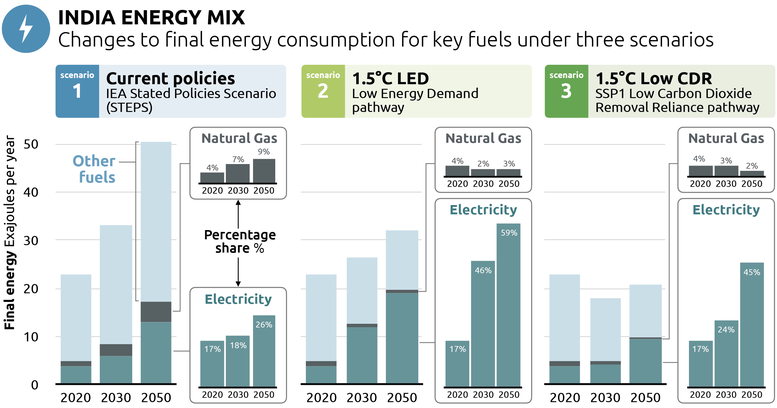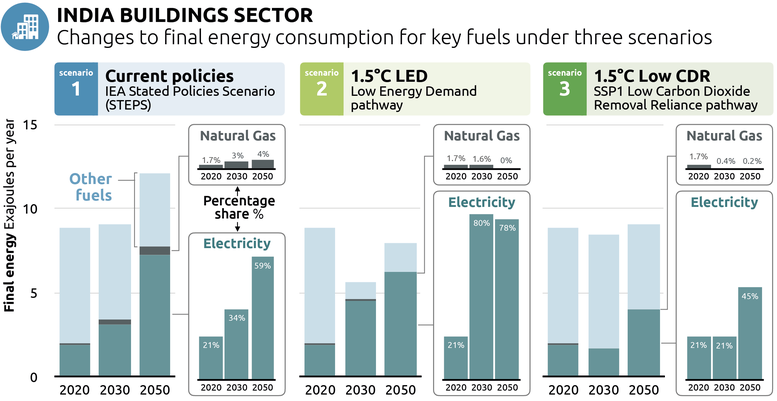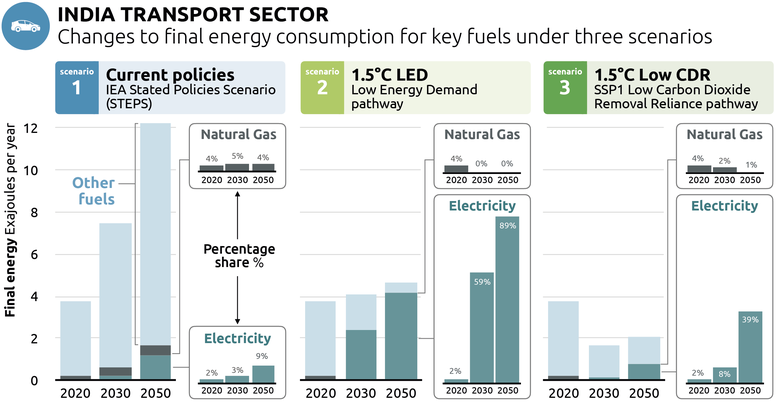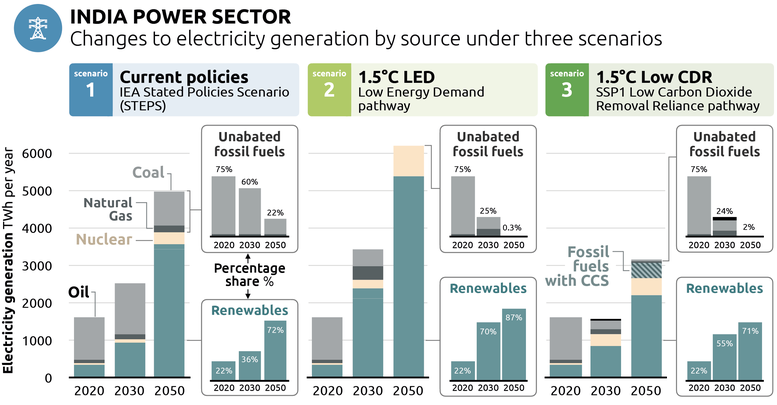Natural gas in India: A pathway towards reducing India’s dependency on gas
Attachments
Natural gas in India is on the rise
In this report, we have analysed India’s potential savings on gas imports and an improved trade balance in a 1.5°C compatible low gas scenario. Our analysis shows that if India aligns with a 1.5°C compatible pathway, it would lead to gas import savings of USD 9-24 bn in 2030 under various price and import assumptions. This would result in average annual import savings of USD 5-12 bn between 2021-2030 under various import assumptions.
Gas is a fossil fuel and not a viable ‘bridge’ for the energy transition. Yet, we continue to see expansion and investments in fossil gas around the world.
The Indian government has recently announced that it plans to increase its share of gas consumption, and transform the country into a “gas-based economy”. It has set a target to increase the share of gas in its energy mix from 6% in 2021 to 15% by 2030.
With the planned increase in gas consumption, India will likely need to significantly increase gas imports, as domestic production has remained stagnant, and invest in capital-intensive gas infrastructure. This exposes India to risks such as a carbon lock-in, stranded assets, and energy insecurity.

*Final energy was calculated for both current policies and selected 1.5°C pathways as the aggregate of industry, buildings and transport final energy consumption for comparability.
1.5°C compatible pathways show significantly lower gas development across end use sectors
Modelled domestic mitigation pathways for India derived from global 1.5°C compatible pathways show significantly lower gas development across end use sectors (industry, transport, buildings), supported by rapid electrification of end use sectors, with a shift to renewables in the power sector.
Industry is the biggest consumer of fossil gas in India where, apart from being used for energy purposes, it is used as a feedstock for manufacturing fertiliser and petrochemicals. While fossil gas only accounted for 5% of industrial final energy consumption in 2020, the current policies scenario, based on IEA STEPS, shows a five-fold increase in gas use by 2050, reaching 13% of industrial final energy consumption. In contrast, our analysed 1.5°C scenarios show a limited role for fossil gas in industry, contributing just 3–4% to industrial final energy consumption in 2050.

Historically, demand for gas in India’s building sector has not been very high, largely due to lack of access. However, with increased expansion of the city gas distribution (CGD) network, natural gas use in the buildings sector has more than doubled over the past decade and now makes up around 10% of gas demand. The current policies scenario shows a continued rise in gas demand in the buildings sector out to 2050, while our selected 1.5 ̊C pathways show negligible gas in the buildings sector by 2030.

India’s transport sector is dominated by oil with natural gas playing a relatively minor role. The use of compressed natural gas (CNG) in the transport sector has increased over the past years and is prevalent in 11 out of 29 states constituting 11% of the CGD network. Our selected Paris Agreement compatible pathways show a rapid electrification of the transport sector, with the share of electricity in the sector’s energy mix increasing to about 40–90% by 2050.

Fossil gas plays a relatively minor role in India’s power sector, supplying only 4% of the generation mix in 2020, but substantial growth is projected under current policies. The current plans of replacing coal with fossil gas in power generation would undermine the ability of the power sector to achieve sufficient emissions reductions and pose a challenge for the transformation of the power system, with high risks of stranded assets in a Paris Agreement compatible world.

To meet its growing energy demand, India could scale up its efforts to build its renewable energy capacity, rather than relying on fossil gas. A shift to renewables comes with other benefits, beyond climate protection, such as job creation and energy independence for the country. This could be achieved by redirecting funds meant for gas infrastructure to increasing electrification and developing new technologies, like green hydrogen and battery storage. International climate finance will be needed to support India’s economic transformation.
Ambitious renewable capacity provides an opportunity to increase the rate of electrification to meet energy requirements in end-use sectors (industry, buildings and transport). The use of green hydrogen for non-energy purposes is another opportunity, especially given the Indian government is already developing policies to increase the use of green hydrogen in the industry sector.
Benefits of reduced reliance on natural gas
India is the world’s fourth largest LNG importer: net imports have increased by 84% over the past decade. Increasing dependence on gas imports is a threat to India’s energy independence and security. Import dependency may lead to vulnerability in the case of international political changes. Spot LNG prices have seen extreme volatility in the past two years, and that has become a major concern for all gas importing countries, including India.
Our analysis shows that if India aligns with a 1.5°C compatible pathway, it would lead to gas import savings of USD 9-24 bn in 2030 under various price and import assumptions. This would result in average annual import savings of USD 5-12 bn between 2021-2030 under various import assumptions.

India’s plans to expand import and downstream gas infrastructure are also subject to significant transition risks. In particular, new and existing natural gas infrastructure is at risk of stranding—the premature write-down or devaluation of assets. The lifetime of natural gas infrastructure often spans many decades, and repurposing for green hydrogen faces severe limitations.
Import savings, combined with unspent investment currently planned for gas infrastructure, could instead be channelled towards supplying the population with sustainable energy. Although India’s renewable electricity is growing at a fast rate, it could still do more, given its abundant renewable resources, and this will require investment not only in renewable resources, but also in the development and deployment of advanced technologies like green hydrogen and grid scale battery storage. International financial and other support will be essential to enable India to achieve these crucial transitions and get onto a 1.5°C pathway, and in doing so to reap the benefits of a clean and secure energy system.
Stay informed
Subscribe to our newsletter